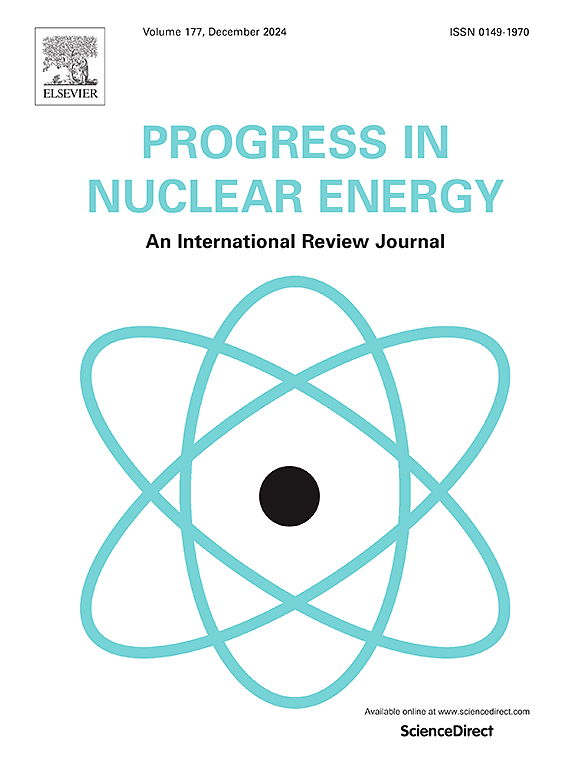福岛第一核电站事故下海洋放射性核素扩散数值模拟及参数分析
IF 3.3
3区 工程技术
Q1 NUCLEAR SCIENCE & TECHNOLOGY
引用次数: 0
摘要
2011年福岛第一核电站发生核事故后,受放射性污染的水被排放到太平洋。了解海洋放射性核素扩散行为对准确评价海洋放射性污染水排放的辐射效应具有重要意义。海洋放射性核素的扩散受风场、潮汐、海底地形、温度和盐度等因素的影响。考虑复杂环境因素的海洋放射性核素扩散模拟存在较大的不确定性。利用mik3fm计算平台,建立了考虑多种环境因素的海流与潮汐耦合边界驱动的福岛海洋放射性核素扩散模型。在国际原子能机构MODARIA计划框架下,基于基准进行了模型精度验证和模型间偏置机理分析比较。讨论了层网格的垂直分布、网格分辨率、温度和盐度、水平扩散参数、风特征以及潮汐强迫对扩散行为的影响。结果表明,所建立的模型能较准确地描述福岛近岸海域的海流,并能预测海流的扩散轨迹、浓度水平和分布。为提高模型的预测精度,应考虑增加关注区域的垂直层数、风力数据和细化网格。模型和参数分析有助于减少预测福岛核电站东部辅助水域放射性水平的不确定性。本文章由计算机程序翻译,如有差异,请以英文原文为准。
Numerical modeling and parameters analysis of marine radionuclide dispersion under the Fukushima Daiichi nuclear accident
Radioactive contaminated water was released into the Pacific Ocean under the Fukushima Daiichi nuclear accident in 2011. Knowledge of the marine radionuclide dispersion behaviors is significant to accurately evaluate radiation effects due to ocean discharge of radioactive contaminated water. The marine radionuclide dispersion is affected by wind field, tide, seafloor topography, temperature and salinity, etc. Significant uncertainty exists in marine radionuclide dispersion simulation with the consideration of complex environmental factors. MIKE 3 FM computational platform was used to establish a Fukushima marine radionuclide dispersion model driven by ocean current and tidal coupling boundary under consideration of various environmental factors. Further, the model accuracy validation with measurement data and inter-models’ comparison for bias mechanism analysis were performed based on the benchmark under the frame of IAEA MODARIA Programme. The effects of vertical distribution of layers mesh, grid resolution, temperature and salinity, horizontal diffusion parameters, wind characteristics as well as tidal forcing on the dispersion behavior were discussed. The results show that the established model can accurately describe the oceanic currents in the coastal waters of Fukushima and predict the dispersion trajectory, as well as concentration level and distribution. More vertical layers, wind-driven forces data and refined mesh for the area of concern should be considered to improve the predictive accuracy of model. The modeling and parameters analysis can help to decrease uncertainty in predicting the levels of radioactivity in the adjutant waters east of the Fukushima site.
求助全文
通过发布文献求助,成功后即可免费获取论文全文。
去求助
来源期刊

Progress in Nuclear Energy
工程技术-核科学技术
CiteScore
5.30
自引率
14.80%
发文量
331
审稿时长
3.5 months
期刊介绍:
Progress in Nuclear Energy is an international review journal covering all aspects of nuclear science and engineering. In keeping with the maturity of nuclear power, articles on safety, siting and environmental problems are encouraged, as are those associated with economics and fuel management. However, basic physics and engineering will remain an important aspect of the editorial policy. Articles published are either of a review nature or present new material in more depth. They are aimed at researchers and technically-oriented managers working in the nuclear energy field.
Please note the following:
1) PNE seeks high quality research papers which are medium to long in length. Short research papers should be submitted to the journal Annals in Nuclear Energy.
2) PNE reserves the right to reject papers which are based solely on routine application of computer codes used to produce reactor designs or explain existing reactor phenomena. Such papers, although worthy, are best left as laboratory reports whereas Progress in Nuclear Energy seeks papers of originality, which are archival in nature, in the fields of mathematical and experimental nuclear technology, including fission, fusion (blanket physics, radiation damage), safety, materials aspects, economics, etc.
3) Review papers, which may occasionally be invited, are particularly sought by the journal in these fields.
 求助内容:
求助内容: 应助结果提醒方式:
应助结果提醒方式:


